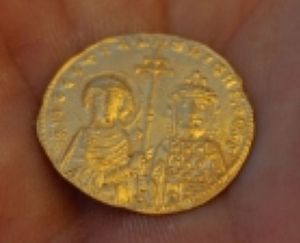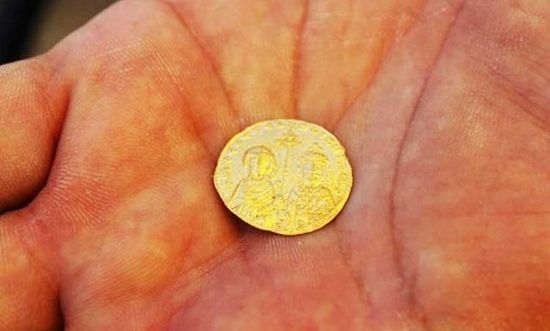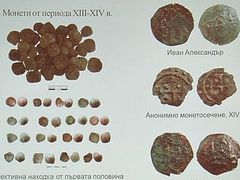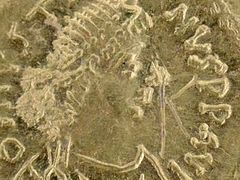Source: Archaeology in Bulgaria
August 4, 2016
 This perfectly preserved gold coin of Byzantine Emperor Nicephorus II Phocas has been found in the ruins of the medieval Bulgarian city of Karvuna in today’s Balchik. Photo: Balchik Municipality
This perfectly preserved gold coin of Byzantine Emperor Nicephorus II Phocas has been found in the ruins of the medieval Bulgarian city of Karvuna in today’s Balchik. Photo: Balchik Municipality
A perfectly preserved gold coin of 10th century Byzantine Emperor Nicephorus II Phocas (r. 963-969) has been discovered during archaeological excavations of the medieval fortress Karvuna in the Bulgarian Black Sea town of Balchik.
The gold coin which features the images of the Holy Mother of God (Virgin Mary) and Byzantine Emperor Nicephorus II Phocas has been found by an archaeological team from Sofia University “St. Kliment Ohridski" led by Dr. Chavdar Kirilov and Dr. Rumyana Koleva, Balchik Municipality has announced.
Bulgaria’s Black Sea town of Balchik is the successor of a total of three ancient and medieval settlements. It first originated as an Ancient Thracian settlement which was later colonized by the Ancient Greeks, and was first named Krounoi and then Dionysopolis.
After a devastating flood of 544-545 AD (a tsunami in the Black Sea caused by an earthquake), the population of the Antiquity city of Dionysopolis is believed to have moved to the fortress which was located about 1 km away from the Black Sea coast, on a plateau with an altitude of up to 220 meters, in today’s Horizont Quarter of Balchik. It has an area of about 150 decares (app. 37 acres), and the archaeologists have excavated fully its western, northern, and part of the southern fortress wall, with numerous fortress towers. The foundations of the Early Byzantine wall are 3.2 meters wide. This was the medieval Bulgarian city of Karvuna.
The Black Sea town of Balchik is also known for a well preserved goddess Cybele which was discovered in April 2007 during the construction of a hotel on private property. Other cultural landmarks of town include the recently restored Old Mill located near the Port of Balchik, which was built in 1909, the joint Christian and Muslim shrine Ak Yazala Baba – St. Athanasius near the town of Obrochishte, and the so called Palace and the Balchik Botanical Garden.
According to Radostina Encheva, Director of the Balchik Museum of History, the newly found medieval Byzantine gold coin is so well preserved that it can be exhibited as part of the collection of the museum right away, with little need for restoration.
During their 2016 summer digs in Balchik so far, the archaeologists have discovered a bronze ring and have unearthed the foundations of residential buildings from the Middle Ages. The excavations there have 20 more days to go.
Shortly after the discovery of the gold coin made headlines in Bulgaria, the local authorities and the police in Balchik have had to boost the security of the ruins of the medieval fortress Karvuna, Encheva has revealed, as cited by local news site Top Novini Dobrich.
The archaeologists and the municipality are worried that treasure hunters might try to raid the ruins in search for more gold coins, and there are even reports of suspicious vehicles noticed close to the archaeological site. These concerns are valid given the rampant treasure hunting and looting of archaeological sites all over Bulgaria.
Byzantine Emperor Nicephorus II Phocas is known for his military prowess which led to a resurgence of the Byzantine Empire in the 10th-11th century, and, as far as Bulgaria is concerned, for his contribution to the decline and ultimate demise of the First Bulgarian Empire (632/680 – 1018 AD).
The reign of Nicephorus II coincided with the end of the long reign of Bulgarian Tsar Petar I (r. 927-969) which was known as a period of relatively stability but also relative decline of the huge First Bulgarian Empire.
In 967, the Byzantine Emperor started a war against Bulgaria, and managed to revoke the annual tribute that Byzantium had been paying to the First Bulgarian Empire. Subsequently, he bribed with 15,000 pounds of gold Knyaz Sviatoslav I of Kievan Rus to literally “stab Bulgaria in the back”.
Byzantine Emperor Nicephorus II Phocas was assassinated in 969 by his general, nephew, and successor, Emperor John I Tzimiskes.
Kievan Knyaz Sviatoslav I’s highly successful invasion weakened the First Bulgarian Empire to such an extent that in 971 Nicephorus II’s successor, Byzantine Emperor John I Tzimiskes (r. 969-976) was able to capture the Bulgarian capital Veliki Preslav, stripped the captive Bulgarian Tsar Boris II (r. 970-971) of his imperial symbols, and proclaimed the annexation of Bulgaria.
The First Bulgarian Empire, however, survived for 50 more years, until 1018, under the leadership of general and later Tsar Samuil (r. 997-1014) shifting its power center to the southwest, with its capital in Ohrid (today in the Republic of Macedonia).
 Another view of the newly discovered medieval Byzantine gold coin from Bulgaria’s Balchik. Photo: Top Novini Dobrich
Another view of the newly discovered medieval Byzantine gold coin from Bulgaria’s Balchik. Photo: Top Novini Dobrich
Background Infonotes:
Bulgaria’s Black Sea town of Balchik is the successor of a total of three ancient and medieval settlements. It first originated as an Ancient Thracian settlement which was later colonized by the Ancient Greeks, and was first named Krounoi and then Dionysopolis. Subsequently, it became an Ancient Roman, Early Byzantine, and Ancient Bulgar / medieval Bulgarian city Karvuna.
The Greek colonization of the Thracian settlement on the Western Black Sea coast most likely began in the 6th-5th century BC by Ionian Greeks, possibly from the city of Miletus on the Anatolian coast, or from Miletus’s colonies Apollonia Pontica (today’s Bulgarian resort of Sozopol), or Histria (today on Romania’s Black Sea coast).
According to Herodotus, Dionysopolis was founded at the time of the reign of Astyages, King of the Median Empire (r. 585-550 BC). At first named Krounoi (meaning “springs") and inhabited by Thracians, Scytians, and Greeks, in the 3rd century BC the colony was renamed Dionysopolis after the sea washed ashore a wooden statue of god Dionysus. The Ancient Greek colony was located where today’s Balchik has its fishing port.
There are hypotheses that in the Antiquity period Dionysopolis was badly damaged by an earthquake, and that much of the ancient city might have sunk in the Black Sea. Dionysopolis was conquered by the Ancient Thracian Odrysian Kingdom during the reign of King Sitalces (r. 431-424 BC), and began part of the Roman Empire after in 46 AD Rome conquered the Odrysian Kingdom and all of Ancient Thrace south of the Danube. Thus, in the 1st century AD, it was made part of the Roman province of Moesia Inferior. At the end of the 3rd century, it became one of the main cities of the province of Scythia Minor. During the Antiquity period, Dionysopolis had a Temple of ancient goddess Cybele, which was found by accident during construction works in Bulgaria’s Balchik in 2007.
After the division of the Roman Empire in 396 AD, Dionysopolis remained in the Eastern Roman Empire known today as Byzantium. The construction of the Early Byzantine fortress of Dionysopolis is believed to have started during the reign of Emperor Anasthasius I Dicorus (r. 491-518 AD), and to have been completed during the reign of Emperor Justinian I the Great (r. 527-565 AD).
According to Byzantine historian Theophanes the Confessor (ca. 760-817/818), in 544-545 AD, the Black Sea rose and invaded the land up to a distance of 3-4 km at Odessos (Varna), Dionysopolis (Balchik), and Aphrodision, another ancient city on the Black Sea coast located 4 km north of today’s Balchik. It was this tsunami/flood that caused a landslide that sealed off the Cybele Temple discovered in 2007, and that also destroyed for good the neighboring city of Aphrodision.
After the devastating flood of 544-545 AD (possibly caused by a tsunami in the Black Sea), the population of the Antiquity city of Dionysopolis is believed to have moved to the fortress which was located about 1 km away from the Black Sea coast, on a plateau with an altitude of up to 220 meters, in today’s Horizont Quarter of Balchik. It has an area of about 150 decares (app. 37 acres), and the archaeologists have excavated fully the western, northern, and part of the southern fortress wall, with numerous fortress towers. The foundations of the Early Byzantine wall are 3.2 meters wide.
In the 7th century AD, the First Bulgarian Empire (632/680-1018 AD) conquered the area of Dionysopolis from the Byzantine Empire during the reign of Khan (Kanas) Asparuh (r. 680-700/701 AD). The area was settled by Ancient Bulgars who called the city Karvuna – the name Balchik was known with until the 14th century (the medieval city of Karvuna must not be confused with today’s town of Karvuna, which is also located in Balchik Municipality). In the first 300 years of the First Bulgarian Empire, the area around Karvuna was a densely settled and heavily fortified to protect the Bulgarian capitals Pliska and Veliki Preslav located some 100 km to the east from Black Sea invasions.
In 2007, during excavations of the early medieval Bulgar city of Karvuna, archaeologists found six Ancient Bulgar graves from the end of the 7th century AD, which is believed to be the earliest known Ancient Bulgar necropolis on the territory of today’s Bulgaria. Karvuna was a major city during the Second Bulgarian Empire (1185-1396 AD) as well.
The city was mentioned in a certificate issued in 1230 AD by Bulgarian Tsar Ivan Asen II (r. 1218-1241 AD) granting trading rights to merchants from the Adriatic city of Dubrovnik, after the Battle of Klokotnitsa. An Italian naval map of the Black Sea from 1296 AD mentioned Karvuna as “Carbona". In the middle of the 14th century, Karvuna, today’s Balchik, became the capital of Bulgarian boyar Balik (r. ca. 1337-1366 AD), a powerful feudal lord who acquired independence from the Bulgarian Tsar setting up the so called Dobrudzha Despotate, also known as the Principality of Karvuna, in the region of Dobrudzha, today’s Northeast Bulgaria and Southeast Romania.
During his reign, Balik built another fortress which also falls within today’s town of Balchik. Its ruins are located in the Gemidzhiya Quarter. Thus, Balchik has a total of three predecessors – the Ancient Thracian, Greek, and Roman city of Dionysopolis, the early medieval Byzantine fortress later turned a medieval Bulgarian city, and Balik’s 14th century fortress. After Balik’s death, his son Despot Dobrotitsa moved his capital from Karvuna to the fortress of Kaliakra, on the Cape of Kaliakra, near today’s town of Kavarna (also not to be confused with Karvuna).
As one of several Bulgarian states in the Balkans mired in dynastic and feudal conflict at the end of the 14th century together with the Tarnovo Tsardom, the Vidin Tsardom, and the feudal states in the geographic regions of Thrace and Macedonia, the Dobrudzha Despotate was conquered by the invading Ottoman Turks by the turn of the century putting an end of the Second Bulgarian Empire. It is widely believed that the name of today’s town of Balchik is derived from the name of its feudal ruler Balik, while the name of Despot Dobrotitsa gave the name of the region of Dobrudzha.



